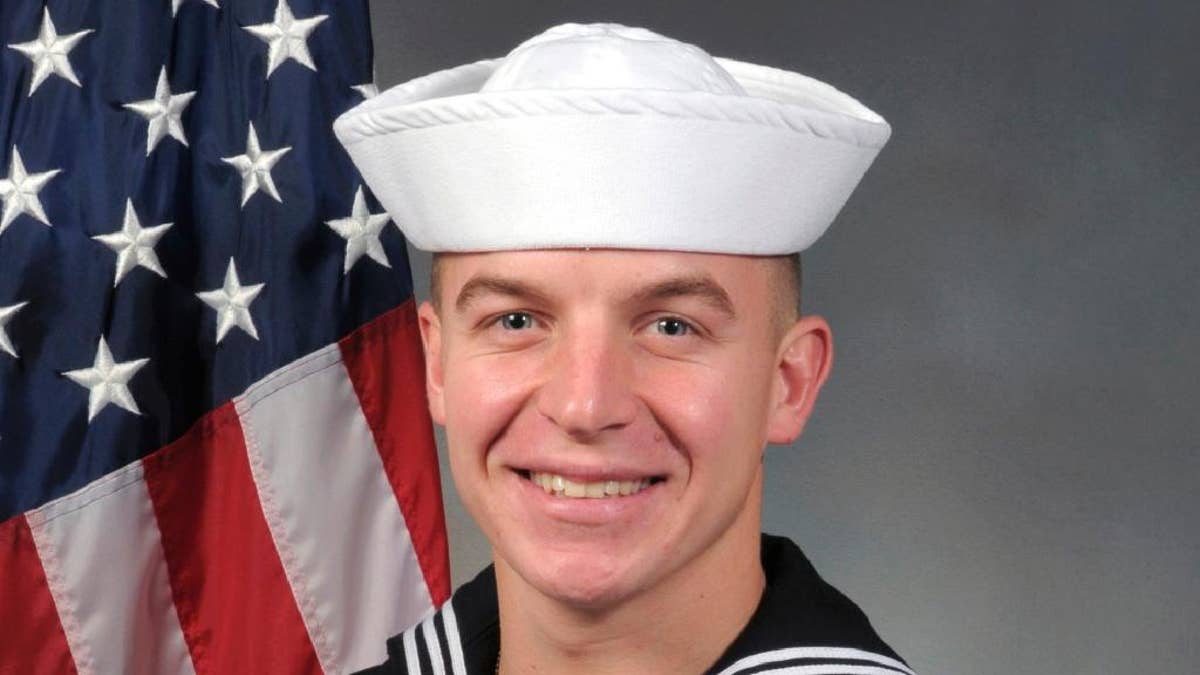
FILE - In this undated file photo released by the Naval Special Warfare Center shows Seaman James "Derek" Lovelace. Lovelace, a Navy SEAL trainee who died during his first week of basic training in Coronado, Calif. A Southern California medical examiner says Lovelace was repeatedly dunked by an instructor in his first week of basic training and has ruled his death a homicide. The San Diego County autopsy report released Wednesday, July 6, says Lovelace's cause of death is drowning with a contributing heart problem. The homicide ruling doesn't necessarily mean a crime occurred, and the instructor hasn't been charged. (Naval Special Warfare Center via AP, File) (The Associated Press)
SAN DIEGO – The Navy SEALs basic training is designed to be a difficult selection process to find the U.S. military's strongest fighters and turn them into an elite force able to dive into the world's deadliest places from Somalia to Syria.
Seaman James Derek Lovelace was in his first week of the six-month program in Coronado, near San Diego, when he died during the strenuous training.
His lips turning blue and his face purple, the Navy SEAL trainee dressed in full gear was treading water in a giant pool when his instructor pushed him underwater at least twice — actions a medical examiner ruled Wednesday made his drowning death a homicide, not an accident.
The highly unusual ruling is serious and could affect the SEALs' basic training practices, said former Navy Capt. Lawrence Brennan, an adjunct professor at Fordham Law School who served as a Navy judge advocate.
The ruling on the May 6 drowning of the 21-year-old raises questions about the safety of the grueling training that some argue is necessary to create warriors charged with missions like the one that took down Osama Bin Laden. It also raises questions about where the line is drawn between what is considered to be rigorous training to weed out the weakest and abuse that leads to a homicide.
Lovelace, of Crestview, Florida, was starting out in the toughest phase of basic training that culminates in "Hell Week" — when candidates spend five-and-a-half days of running, climbing, swimming in frigid waters, and other drills, and get a total of four hours of sleep. On average, 75 percent of trainees drop out after "Hell Week."
The autopsy found Lovelace had an enlarged heart and called it a contributing factor but said the cause of death was drowning.
The investigation's outcome could lead to the instructor facing a number of military charges — from dereliction of duty for not following safety procedures all the way up to homicide. So far, the instructor has not been accused of any wrongdoing.
"I think it's sort of a warning to revisit training procedures and make sure they are fully understood and implemented," Brennan said.
But people should remember the harsh drills — which can appear to border on torture — also help prepare fighters who will likely encounter much more treacherous situations on their missions, he added.
"Waterboarding has been done on aviators going into combat because it was expected the enemies could do this to them," he said. "But perhaps in this case, someone did do something wrong."
Several former SEALs told The Associated Press the instructor's actions did not strike them as unusual.
But the medical examiner disagreed. Instructors are supposed to splash, make waves and yell at the students but they are advised not to dunk or pull students underwater, according to the report.
"It is our opinion that the actions, and inactions, of the instructors and other individuals involved were excessive and directly contributed to the death," the report said.
The Navy is investigating and has assigned the instructor to administrative duties. Officials declined to release any details on the instructor.
Lovelace was reportedly not a strong swimmer, according to the report. He struggled shortly after he started treading water in fatigues, boots and a dive mask filled with water in the heated pool, which ranged in depth from four-to-15 feet.
He was seen on surveillance video being dunked at least twice by an instructor, the report said.
He also slipped underwater several times as the instructor followed him around, continually splashing him for about five minutes, the report said. Several other instructors also splashed him.
At one point in the training, a fellow trainee tried to help Lovelace keep his head above water. Video appears to show the instructor dunking Lovelace and later pulling him partially up and out of the water and then pushing him back, the autopsy report said.
Multiple people stated that his face was purple and his lips were blue, according to the report. One individual considered calling a "time-out" to stop the exercise, the report said.
Lovelace lost consciousness after he was pulled from the pool. He was taken to a civilian hospital, where he died.

